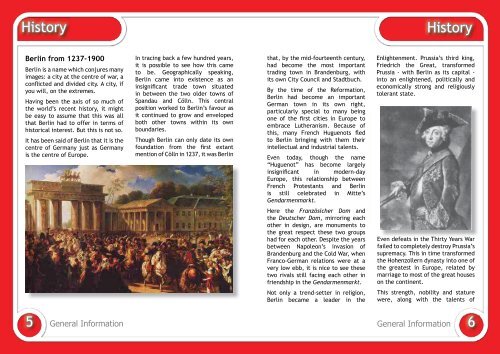You also want an ePaper? Increase the reach of your titles
YUMPU automatically turns print PDFs into web optimized ePapers that Google loves.
History History<br />
<strong>Berlin</strong> from 1237-1900<br />
<strong>Berlin</strong> is a name which conjures many<br />
images: a city at the centre of war, a<br />
confl icted and divided city. A city, if<br />
you will, on the extremes.<br />
Having been the axis of so much of<br />
the world’s recent history, it might<br />
be easy to assume that this was all<br />
that <strong>Berlin</strong> had to offer in terms of<br />
historical interest. But this is not so.<br />
It has been said of <strong>Berlin</strong> that it is the<br />
centre of Germany just as Germany<br />
is the centre of Europe.<br />
In tracing back a few hundred years,<br />
it is possible to see how this came<br />
to be. Geographically speaking,<br />
<strong>Berlin</strong> came into existence as an<br />
insignifi cant trade town situated<br />
in between the two older towns of<br />
Spandau and Cölln. This central<br />
position worked to <strong>Berlin</strong>’s favour as<br />
it continued to grow and enveloped<br />
both other towns within its own<br />
boundaries.<br />
Though <strong>Berlin</strong> can only date its own<br />
foundation from the fi rst extant<br />
mention of Cölln in 1237, it was <strong>Berlin</strong><br />
that, by the mid-fourteenth century,<br />
had become the most important<br />
trading town in Brandenburg, with<br />
its own City Council and Stadtbuch.<br />
By the time of the Reformation,<br />
<strong>Berlin</strong> had become an important<br />
German town in its own right,<br />
particularly special to many being<br />
one of the fi rst cities in Europe to<br />
embrace Lutheranism. Because of<br />
this, many French Huguenots fl ed<br />
to <strong>Berlin</strong> bringing with them their<br />
intellectual and industrial talents.<br />
Even today, though the name<br />
“Huguenot” has become largely<br />
insignifi cant in modern-day<br />
Europe, this relationship between<br />
French Protestants and <strong>Berlin</strong><br />
is still celebrated in Mitte’s<br />
Gendarmenmarkt.<br />
Here the Französicher Dom and<br />
the Deutscher Dom, mirroring each<br />
other in design, are monuments to<br />
the great respect these two groups<br />
had for each other. Despite the years<br />
between Napoleon’s invasion of<br />
Brandenburg and the Cold War, when<br />
Franco-German relations were at a<br />
very low ebb, it is nice to see these<br />
two rivals still facing each other in<br />
friendship in the Gendarmenmarkt.<br />
Not only a trend-setter in religion,<br />
<strong>Berlin</strong> became a leader in the<br />
Enlightenment. Prussia’s third king,<br />
Friedrich the Great, transformed<br />
Prussia - with <strong>Berlin</strong> as its capital -<br />
into an enlightened, politically and<br />
economically strong and religiously<br />
tolerant state.<br />
Even defeats in the Thirty Years War<br />
failed to completely destroy Prussia’s<br />
supremacy. This in time transformed<br />
the Hohenzollern dynasty into one of<br />
the greatest in Europe, related by<br />
marriage to most of the great houses<br />
on the continent.<br />
This strength, nobility and stature<br />
were, along with the talents of<br />
5 General Schöneberg Information General Schöneberg Information 6


